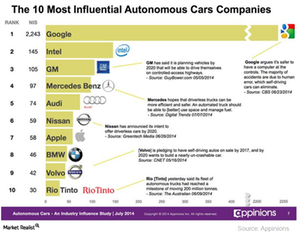Where Intel Really Stands in the Autonomous Vehicle Market
Intel (INTC) is looking to become a complete technology solutions provider for automakers who want to enter the autonomous driving space.
Aug. 31 2017, Updated 7:36 a.m. ET

Can Intel overtake Nvidia in autonomous vehicle technology?
Intel (INTC) is looking to become a complete technology solutions provider for automakers who want to enter the autonomous driving space. The company has acquired several companies to integrate their technologies into its offerings. It plans to build and test a fleet of 100 cars with level-4 autonomy in the United States, Israel, and Europe (IEV), with the first vehicles expected to hit the road in 2017.
In level-4 autonomy, a car can drive by itself with an option to hand over controls to human. In level-5 autonomy, human control is completely removed. In its level-4 autonomous cars, Intel would combine its cloud connectivity and central processing technology with Mobileye’s image processors and mapping software to enable the car to make real-time decisions on the road.
Can Intel live up to its claim?
Waymo has been working on self-driving cars since 2009, whereas Audi and Nvidia (NVDA) have been working on autonomous driving only since 2015. But after working for so many years, these companies are still only at level-3 autonomy.
Intel is new to autonomous driving and is already claiming level-4 autonomy. In its announcement of 100 autonomous test vehicles, Intel didn’t specify the capabilities of these vehicles. Its idea of an autonomous car platform is to combine various types of chips from Atom to Xeon with a FPGA (field-programmable gate array). However, this solution may not be viable due to its huge cost, large size, and high power consumption.
Some analysts believe that Intel should be able to compete with Nvidia’s Drive PX-2 platform in the future. But even if Intel manages to build an autonomous car platform in the future, it may not be a part of the first wave of autonomous cars that hit the road, given the long development cycles of automotive products.
Automakers make design decisions several years before the production begins, and in this way, the cars of tomorrow feature the technologies of today. Nvidia’s current technology is more advanced and production-ready, whereas Intel is still developing its technology. Moreover, Intel lags behind in deep learning technology, which is necessary to support autonomous cars.
However, there’s still hope for Intel to make it big in the autonomous car market. We’ll discuss this further in the next part.
